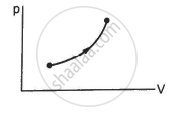Advertisements
Advertisements
प्रश्न
A sample of an ideal gas (γ = 1.5) is compressed adiabatically from a volume of 150 cm3 to 50 cm3. The initial pressure and the initial temperature are 150 kPa and 300 K. Find (a) the number of moles of the gas in the sample (b) the molar heat capacity at constant volume (c) the final pressure and temperature (d) the work done by the gas in the process and (e) the change in internal energy of the gas.
उत्तर
The ideal gas equation is
PV = nRT
Given, P1 = 150 kPa = 150 × 103 Pa
V1 = 150 cm3 = 150 × 10−6 m3
T1= 300 K
(a)
`"n" =("P""V")/("R""T") = 9.036 xx 10^-3`
n = 0.009
(b)
`"C"_"p"/"C"_"v" = gamma , "C"_"p" -"C"_"v" ="R"`
So, `"C"_"v" = "R"/(gamma-1) = 2"R" = 8.3/0.5 = 16.6 "J" "mol" -"K"`
(c) Given,
P1 = 150 kPa = 150 × 103 Pa
P2 = ? V1 = 150 cm3
= 150 × 10−6 m3
γ = 1.5
V2 = 50 cm3 = 50 × 10−6 m3,
T1 = 300 K
T2 = ?
Since the process is adiabatic, using the equation of an adiabatic process,we get
P1V1γ = P2V2γ
⇒ 150 × 103 × (150 × 10−6)γ = P2 × (50 × 10−6)γ
`=> "P"_2 = 150 xx 10^3 xx ((150 xx 10^-6)^1.5)/(50 xx 10 ^-6)^1.5`
P2 = 150000 × (3)1.5
P2 = 779.422 × 103 Pa
P2 = 780 kPa
Again,
P11−γ T1γ = P11−γ T2γ
⇒ (150 × 103)1−1.5 × (330)1.5 = (780 × 103)1−1.5 × T21.5
⇒ T21.5 = (150 × 103)1−1.5 × (300)1.5 × 3001.5
T21.5 = 11849.050
⇒ T2 = (11849.050)1/1.5
T2 = 519.74 = 520 K
d) dQ = dW + dU
Or dW = −dU [ Since dQ = 0 in an adiabatic process]
dW = −nCvdT
dW = −0.009 × 16.6 × (520 − 300)
dW = −0.009 × 16.6 × 220
dW = −32.87 J ≈ −33 J
(e)
dU = nCvdT
dU = 0.009 × 16.6 × 220 ≈ 33 J
APPEARS IN
संबंधित प्रश्न
Estimate the fraction of molecular volume to the actual volume occupied by oxygen gas at STP. Take the diameter of an oxygen molecule to be 3Å.
An air bubble of volume 1.0 cm3 rises from the bottom of a lake 40 m deep at a temperature of 12 °C. To what volume does it grow when it reaches the surface, which is at a temperature of 35 °C?
Consider a mixture of oxygen and hydrogen kept at room temperature. As compared to a hydrogen molecule an oxygen molecule hits the wall
Calculate the mass of 1 cm3 of oxygen kept at STP.
An electric bulb of volume 250 cc was sealed during manufacturing at a pressure of 10−3 mm of mercury at 27°C. Compute the number of air molecules contained in the bulb. Avogadro constant = 6 × 1023 mol−1, density of mercury = 13600 kg m−3 and g = 10 m s−2.
Use R=8.314J K-1 mol-1
The density of an ideal gas is 1.25 × 10−3 g cm−3 at STP. Calculate the molecular weight of the gas.
Use R=8.31J K-1 mol-1
Consider a sample of oxygen at 300 K. Find the average time taken by a molecule to travel a distance equal to the diameter of the earth.
Use R=8.314 JK-1 mol-1
Find the ratio of the mean speed of hydrogen molecules to the mean speed of nitrogen molecules in a sample containing a mixture of the two gases.
Use R = 8.314 JK-1 mol-1
Hydrogen gas is contained in a closed vessel at 1 atm (100 kPa) and 300 K. (a) Calculate the mean speed of the molecules. (b) Suppose the molecules strike the wall with this speed making an average angle of 45° with it. How many molecules strike each square metre of the wall per second?
Use R = 8.31 JK-1 mol-1
A vertical cylinder of height 100 cm contains air at a constant temperature. The top is closed by a frictionless light piston. The atmospheric pressure is equal to 75 cm of mercury. Mercury is slowly poured over the piston. Find the maximum height of the mercury column that can be put on the piston.
A uniform tube closed at one end, contains a pellet of mercury 10 cm long. When the tube is kept vertically with the closed-end upward, the length of the air column trapped is 20 cm. Find the length of the air column trapped when the tube is inverted so that the closed-end goes down. Atmospheric pressure = 75 cm of mercury.
The ratio Cp / Cv for a gas is 1.29. What is the degree of freedom of the molecules of this gas?
Work done by a sample of an ideal gas in a process A is double the work done in another process B. The temperature rises through the same amount in the two processes. If CAand CB be the molar heat capacities for the two processes,
Let Cv and Cp denote the molar heat capacities of an ideal gas at constant volume and constant pressure respectively. Which of the following is a universal constant?
The figure shows a process on a gas in which pressure and volume both change. The molar heat capacity for this process is C.

The molar heat capacity for the process shown in the figure is

